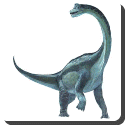 Brachiosaurus — Brachiosaurus meaning “arm lizard”, from the Greek brachion was a genus of sauropod dinosaur that lived during the Late Jurassic Period. It was named thus because its forelimbs were longer than its hind limbs. One of the largest animals ever to walk the earth, it has become one of the most famous of all dinosaurs and is widely recognised worldwide.
Brachiosaurus — Brachiosaurus meaning “arm lizard”, from the Greek brachion was a genus of sauropod dinosaur that lived during the Late Jurassic Period. It was named thus because its forelimbs were longer than its hind limbs. One of the largest animals ever to walk the earth, it has become one of the most famous of all dinosaurs and is widely recognised worldwide.
For many decades, Brachiosaurus was the largest dinosaur known. It has since been discovered that a number of giant titanosaurians (Argentinosaurus, for example) surpassed Brachiosaurus in terms of sheer mass. More recently, another brachiosaurid, Sauroposeidon, has also been discovered; based on incomplete fossil evidence, it too is likely to have outweighed Brachiosaurus.
Brachiosaurus is often considered to be the largest dinosaur known from a relatively complete fossilized skeleton. However, the most complete specimens, including the Brachiosaurus in the Humboldt Museum of Berlin (excavated in Africa, the tallest mounted skeleton in the world), are members of the species B. brancai which some scientists consider to be part of a separate genus, Giraffatitan. The holotype material of the type species, B. altithorax. includes a sequence of seven posterior dorsal vertebrae, sacrum, proximal caudal vertebra, coracoid, humerus, femur and ribs: enough from which to estimate size. Based on a complete composite skeleton, Brachiosaurus attained 25 metres (82 feet) in length and was probably able to raise its head about 13 metres (42 ft) above ground level. Fragmentary material from larger specimens indicates that it could grow 15% longer than this. Such material includes an isolated fibula HMN XV2 1340 cm in length and the brachiosaurid scapulocoracoid referred to Ultrasauros.
Historically, Brachiosaurus has been estimated to have weighed as little as 15 tonnes (Russell et al., 1980) and as much as 78 tonnes. However these extreme estimates are now considered unlikely; that of Russell et al. was based on limb-bone allometry rather than a body model, and Colbert’s was based on an outdated and overweight model. More recent estimates based on models reconstructed from osteology and inferred musculature are in the range 32 tonnes to 37 tonnes (Christiansen 1997). The 15% longer specimens hinted at above would have massed 48 to 56 tonnes.
Brachiosaurus was one of the largest dinosaurs of the Jurassic era; it lived on prairies filled with ferns, bennettites and horsetails, and it moved through vast conifer forests and groves of cycads, seed ferns and ginkgos. Some of its contemporary genera included Stegosaurus, Dryosaurus, Apatosaurus and Diplodocus. While it is speculated that groups of Brachiosaurus moved in herds, fully grown individuals had little to fear from even the largest predators of the time, Allosaurus and Torvosaurus, on account of their sheer size.
Brachiosaurus nostrils, like the huge corresponding nasal openings in its skull, were long thought to be located on the top of the head. In past decades, scientists theorised that the animal used its nostrils like a snorkel, spending most of its time submerged in water in order to support its great mass. The current consensus view, however, is that Brachiosaurus was a fully terrestrial animal. Studies have demonstrated that water pressure would have prevented the animal from breathing effectively while submerged and that its feet were too narrow for efficient aquatic use. Furthermore, new studies by Larry Witmer (2001) show that, while the nasal openings in the skull were placed high above the eyes, the nostrils would still have been close to the tip of the snout (a study which also lends support to the idea that the tall “crests” of brachiosaurs supported some sort of fleshy resonating chamber).
 Kids Portal For Parents India Kids Network
Kids Portal For Parents India Kids Network
